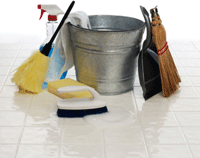Spring Cleaning – Morale Booster?

March 19 was the first day of spring – which makes this a good time to think about some “spring cleaning” around your workplace.
A thorough cleaning can enhance safety by eliminating hazards. Why not welcome in the spring by taking a careful look at some occasional and infrequent housekeeping tasks?
For example, clutter builds up in most work areas, creating such hazards as fire, tripping and blocked exits. Spring cleaning is the perfect time to dispose of:
Trash. Got a pile of broken pallets on the loading dock? Dumped a lot of construction debris on the back lot? Remove anything not in use that has piled up from the site.
Equipment. That frayed sling or wobbly ladder might be out of service, but if it’s not easy to repair, why is it still there?, even if it has a “do not use” tag on it, someone in a hurry or not paying close attention might use it anyway — and regret it afterward.
Chemicals. Old or unused chemicals create unnecessary workplace hazards. They might be flammable or toxic. What’s more, many chemicals that aren’t dangerous when purchased can become so as they deteriorate over time. Dispose of chemicals that are no longer in use, have passed their use-by dates, or have missing or illegible labels.
Clean and Repair. Besides clearing out the clutter, your spring cleaning can address infrequent needs that will boost worker safety and health. For example, maybe it’s time to clean and/or service:
Signs and labels. Signs and labels are important for workplace safety, warning workers of low clearances, identifying machinery controls and power sources, showing workers which direction materials in pipes are flowing, and much, much more. However, they also take a lot of abuse. Replace damaged signs and illegible labels, clean signs that have become too grimy to read, and re-hang signs that have been knocked askew.
Heating, ventilation, and air conditioning (HVAC) systems. A health hazard evaluation by the National Institute for Occupational Safety and Health found that properly maintained HVAC systems were associated with a decreased incidence of lower respiratory symptoms, allergies, and asthma among building occupants. Proper maintenance controls mold, bacteria, allergens, and other contaminants within the system.
Offices. University of Arizona researchers found that office phones, computer keyboards and mice, and desktops harbor 400 times more infectious bacteria than office toilet seats. Yet in most offices, vacuuming and emptying the trash are the only regular cleaning performed. Encourage workers to take disinfecting wipes to office surfaces — not just once a year, but daily if possible — to reduce infectious illness transmission in the workplace. Also, have your cleaning crew do an extra thorough job from time to time.
Remember, the cleaner your workplace, the safer your workers. Our risk management professionals would be happy to chat further– just give us a call.

Comments
Not found any comments yet.